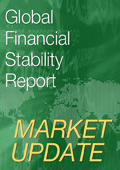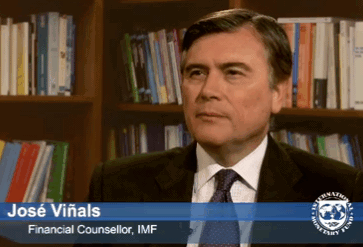
Concerns about debt sustainability and support for adjustment efforts in the euro area periphery have intensified . . .
Market doubts about debt sustainability and support for adjustment programs in the smaller countries of the European periphery have resurfaced. Credit default swap spreads have risen to new highs in Greece amid concerns over the degree of political resolve that will be needed to implement adjustment and secure needed funding. This, in turn, has renewed the market’s focus on the potential for transmission of shocks from sovereigns to banks as banking systems in core European countries still have large exposures to peripheral countries (Figure 2). In a serious market event, a shock could be transmitted beyond the euro zone via both cross-border exposures and a general retraction of risk appetite.

. . . while the outlook for sovereign risk in some larger economies has worsened.
Negative sovereign ratings actions have spread beyond Greece, Ireland, and Portugal further into other euro area countries (Figure 3). This reflects concerns that it will be difficult to reach the political consensus necessary for fiscal consolidation and structural reforms. Market concerns are also rising about the fiscal path in the United States, given little evident progress in breaking the political stalemate over how to carry out needed fiscal consolidation. In the near term, markets have focused on a potential failure to raise the debt ceiling, which the U.S. authorities have estimated will become binding at the beginning of August, absent action. The risk of a temporary default has pushed U.S. short-term CDS spreads above those of some countries rated below the United States’s AAA rating. Even that rating has come under question following S&P’s issuance of a negative outlook in April. In Japan, ratings agencies have downgraded the sovereign outlook on concerns about the government’s ability to achieve deficit reduction.

Prolonged zero interest rates promote risk-taking, including a “search for yield”
Low interest rates in advanced economies are promoting pockets of re-leveraging by lowering the “all-in” cost of debt capital for corporate borrowers. This is encouraging investors to use financial leverage to generate sufficiently attractive returns on equity. Although credit spreads are still higher than before the crisis, ultra-low short-term interest rates mean that the cost of debt is now lower, both for floating-rate and fixed-rate debt. This lower cost of borrowing renders debt servicing ratios more favorable, even at higher debt loads, thereby enabling companies to operate with more financial leverage (Figure 4).

As leveraged loan prices recover (after the deep discounts of 2008–2009) and yields fall, investors are increasingly turning to financial engineering to achieve double-digit returns. Both new and refinanced private equity transactions suggest that related corporate balance sheets are quickly approaching pre-crisis leverage multiples. Though the aggregate amount of financial leverage provided remains far less than before the crisis, high-yield corporate bond and leveraged loan investors have recently been borrowing at higher earnings multiples, not much below 2007 levels.
Notwithstanding recent market jitters, the “search for yield” is also spurring flows into emerging markets, notably corporate debt markets. These inflows, although volatile, are often magnifying already ample domestic liquidity. These conditions, if they continue, risk stretching valuations and raising worries that some countries could be re-leveraging too quickly. Flows into mutual funds for emerging market debt have been strong (behind only high-yield and commodities funds as a percent of total outstanding amounts). Even record amounts of EM corporate bond issuance cannot keep up with demand, and investor due diligence is waning. At nearly $65 billion, external EM corporate debt issuance in the first quarter of 2011 was the highest in three years, and markets expect record issuance for the full year (Figure 5). Emerging market corporate bonds are increasingly seen as substitutes for U.S. corporate high-yield bonds—offering similar market capitalization, lower leverage, and higher returns for the same credit ratings, thus making such bonds attractive to a wider investor base. Although this may represent a healthy development to the extent that some previously credit-constrained companies now have access to capital, the risk is that if the trend continues, too much capital may be moving too quickly to emerging markets. This raises the risk of a mispricing of credit and/or a sudden reversal, if adverse events lead to a rapid retraction in risk appetite.

Although there is little evidence for generalized asset price overvaluation in emerging markets, one area of recent concern has been the real estate sector in fast-growing emerging Asian economies, and possibly a few countries in other EM regions. The pace of property price increases in Asia may be easing (with the possible exception of Hong Kong SAR) on the back of aggressive macroprudential and administrative measures, together with some moderation in economic growth. However, if there were to be a sharp slowdown in growth, this could trigger a large correction in property prices, given their still elevated levels in several markets.
Market concerns about property prices center on China. In order to slow inflation, the central bank has tightened financial policies and hiked policy rates. Should such measures result in an unexpectedly sharp slowdown, the impact on property prices may be even higher. This is in part due to a recent history of strong investment in real estate, including by local authorities as part of the stimulus measures undertaken in response to the global crisis.
Policymakers Must Strive for Rapid Progress on Financial System Robustness
Deep-seated financial challenges remain, even if vulnerabilities are masked by highly accommodative monetary and liquidity conditions. The current window of opportunity to prepare the financial and economic system against potential systemic shocks, importantly by providing clarity on euro area-wide solutions to strains in the periphery, could close unexpectedly. It could be closed by market developments if a sudden pickup in risk aversion (caused, perhaps, by unrelated factors) leads market participants to narrow their tolerance for incomplete policy solutions. It could also be closed by political developments, either because adjustment programs lose political support in debtor countries, or because populaces in creditor countries lose patience in continuing to finance those programs.
Thus, a more robust financial system, notably in Europe, is needed to gird against shocks. This will require a coordinated and cross-border policy response. Though there has been progress on banking system repair, the pace is too slow. First, funding challenges for banks remain. Bank bond yields have risen and some banks in peripheral European countries remain heavily dependent on the European Central Bank (ECB) for liquidity support. In some countries, banks are vulnerable to a further tightening in funding conditions and will need to step up the pace at which they roll over maturing funding.
Second, some banks have not yet sufficiently de-risked their balance sheets, leaving a large measure of uncertainty about asset quality given holdings of legacy assets and significant real estate exposures. Third, the pace of recapitalization needs to be accelerated in order to provide cushions against asset losses or shocks to liquidity (Figure 6). The forthcoming stress tests from the European Banking Authority will represent an important opportunity for updating the assessment of risks in the European banking system and for addressing the weak tail of banks flagged in the April GFSR. It will be critical that, where potential capital gaps are found to exist, plans are seen to be in place to fill them expeditiously, together with the resolution of nonviable banks.

Emerging market policymakers need to guard against overheating and a buildup of financial imbalances amid strong credit growth and rising inflation, exacerbated by capital inflows in some countries. Corporate leverage is also rising and weaker firms are increasingly accessing capital markets. This could make corporate balance sheets more vulnerable to external shocks. With strong domestic demand pressures, especially in emerging Asia and Latin America, macroeconomic measures are needed to avoid overheating, an accumulation of financial risks, and an undermining of policy credibility. Macroprudential tools and, in some cases, a limited use of capital controls, can play a supportive role in managing capital flows and their effects. However, they cannot substitute for appropriate macroeconomic policies.
In sum, policymakers must act now to make the financial system more robust:
- Downside risks have again risen to the fore, including that the global economic recovery may be more fragile than had been thought, so time to address existing vulnerabilities may be running out.
- At the same time, the room for maneuver to counter shocks has been reduced, especially via traditional fiscal and monetary policy levers.
- Thus, it will be critical to make the financial system strong enough to withstand potential major shocks, thereby enabling it to support ongoing recovery. The key priorities are, first, to make the current financial system more robust, especially to clean up from the legacy of the crisis in advanced countries. Second, the financial reform agenda must be completed as expeditiously as possible.
Finally, policymakers must chart a path that supports recovery without allowing a buildup of excessive risks in the future. This is likely to prove particularly challenging in those emerging markets where policymakers face rising inflation pressures and a buildup of financial imbalances. This requires a tightening of macroeconomic policies and use of macroprudential measures.








